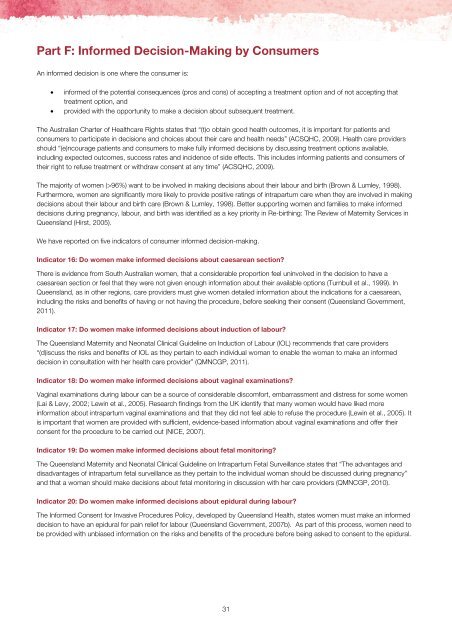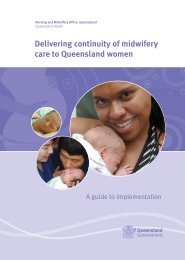Mater Misericordiae Hospital Gladstone - Queensland Centre for ...
Mater Misericordiae Hospital Gladstone - Queensland Centre for ...
Mater Misericordiae Hospital Gladstone - Queensland Centre for ...
You also want an ePaper? Increase the reach of your titles
YUMPU automatically turns print PDFs into web optimized ePapers that Google loves.
Part F: In<strong>for</strong>med Decision-Making by ConsumersAn in<strong>for</strong>med decision is one where the consumer is:• in<strong>for</strong>med of the potential consequences (pros and cons) of accepting a treatment option and of not accepting thattreatment option, and• provided with the opportunity to make a decision about subsequent treatment.The Australian Charter of Healthcare Rights states that “(t)o obtain good health outcomes, it is important <strong>for</strong> patients andconsumers to participate in decisions and choices about their care and health needs” (ACSQHC, 2009). Health care providersshould “(e)ncourage patients and consumers to make fully in<strong>for</strong>med decisions by discussing treatment options available,including expected outcomes, success rates and incidence of side effects. This includes in<strong>for</strong>ming patients and consumers oftheir right to refuse treatment or withdraw consent at any time” (ACSQHC, 2009).The majority of women (>96%) want to be involved in making decisions about their labour and birth (Brown & Lumley, 1998).Furthermore, women are significantly more likely to provide positive ratings of intrapartum care when they are involved in makingdecisions about their labour and birth care (Brown & Lumley, 1998). Better supporting women and families to make in<strong>for</strong>meddecisions during pregnancy, labour, and birth was identified as a key priority in Re-birthing: The Review of <strong>Mater</strong>nity Services in<strong>Queensland</strong> (Hirst, 2005).We have reported on five indicators of consumer in<strong>for</strong>med decision-making.Indicator 16: Do women make in<strong>for</strong>med decisions about caesarean section?There is evidence from South Australian women, that a considerable proportion feel uninvolved in the decision to have acaesarean section or feel that they were not given enough in<strong>for</strong>mation about their available options (Turnbull et al., 1999). In<strong>Queensland</strong>, as in other regions, care providers must give women detailed in<strong>for</strong>mation about the indications <strong>for</strong> a caesarean,including the risks and benefits of having or not having the procedure, be<strong>for</strong>e seeking their consent (<strong>Queensland</strong> Government,2011).Indicator 17: Do women make in<strong>for</strong>med decisions about induction of labour?The <strong>Queensland</strong> <strong>Mater</strong>nity and Neonatal Clinical Guideline on Induction of Labour (IOL) recommends that care providers“(d)iscuss the risks and benefits of IOL as they pertain to each individual woman to enable the woman to make an in<strong>for</strong>meddecision in consultation with her health care provider” (QMNCGP, 2011).Indicator 18: Do women make in<strong>for</strong>med decisions about vaginal examinations?Vaginal examinations during labour can be a source of considerable discom<strong>for</strong>t, embarrassment and distress <strong>for</strong> some women(Lai & Levy, 2002; Lewin et al., 2005). Research findings from the UK identify that many women would have liked morein<strong>for</strong>mation about intrapartum vaginal examinations and that they did not feel able to refuse the procedure (Lewin et al., 2005). Itis important that women are provided with sufficient, evidence-based in<strong>for</strong>mation about vaginal examinations and offer theirconsent <strong>for</strong> the procedure to be carried out (NICE, 2007).Indicator 19: Do women make in<strong>for</strong>med decisions about fetal monitoring?The <strong>Queensland</strong> <strong>Mater</strong>nity and Neonatal Clinical Guideline on Intrapartum Fetal Surveillance states that “The advantages anddisadvantages of intrapartum fetal surveillance as they pertain to the individual woman should be discussed during pregnancy”and that a woman should make decisions about fetal monitoring in discussion with her care providers (QMNCGP, 2010).Indicator 20: Do women make in<strong>for</strong>med decisions about epidural during labour?The In<strong>for</strong>med Consent <strong>for</strong> Invasive Procedures Policy, developed by <strong>Queensland</strong> Health, states women must make an in<strong>for</strong>meddecision to have an epidural <strong>for</strong> pain relief <strong>for</strong> labour (<strong>Queensland</strong> Government, 2007b). As part of this process, women need tobe provided with unbiased in<strong>for</strong>mation on the risks and benefits of the procedure be<strong>for</strong>e being asked to consent to the epidural.31
















